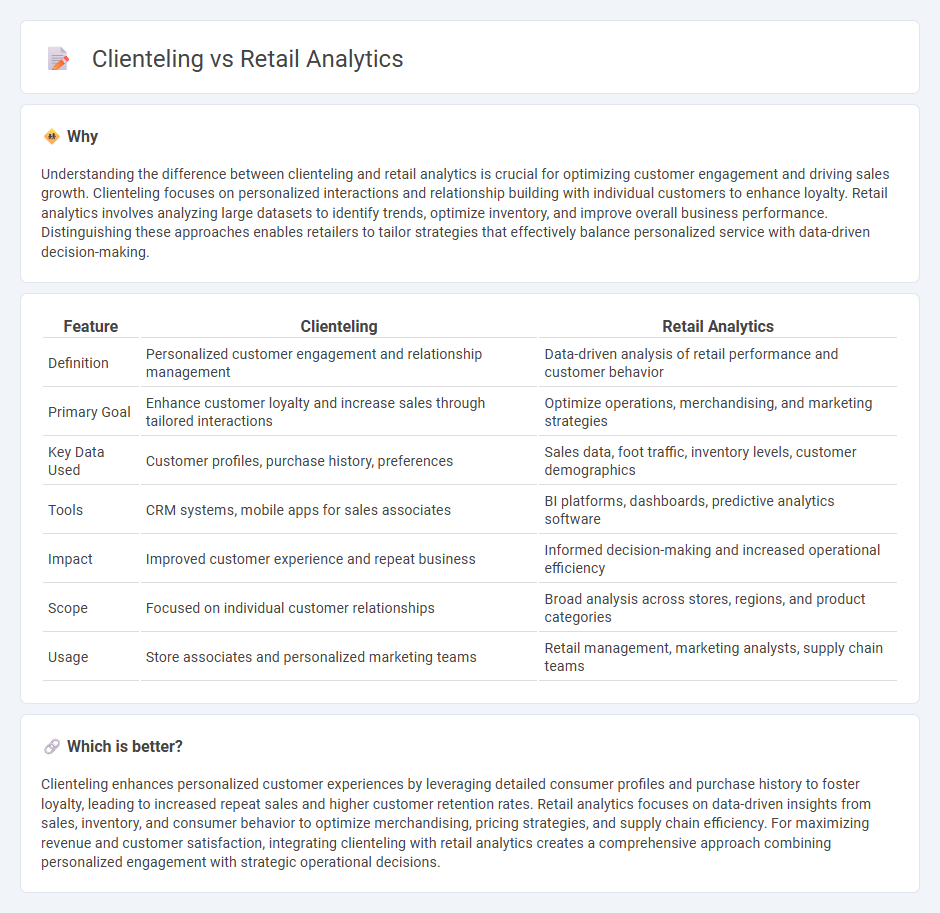
Clienteling enhances retail by enabling personalized customer interactions through detailed profiles and purchase histories. Retail analytics leverages data to optimize inventory, sales strategies, and customer insights for improved business performance. Discover how integrating clienteling and retail analytics transforms the shopping experience and drives growth.
Why it is important
Understanding the difference between clienteling and retail analytics is crucial for optimizing customer engagement and driving sales growth. Clienteling focuses on personalized interactions and relationship building with individual customers to enhance loyalty. Retail analytics involves analyzing large datasets to identify trends, optimize inventory, and improve overall business performance. Distinguishing these approaches enables retailers to tailor strategies that effectively balance personalized service with data-driven decision-making.
Comparison Table
| Feature | Clienteling | Retail Analytics |
|---|---|---|
| Definition | Personalized customer engagement and relationship management | Data-driven analysis of retail performance and customer behavior |
| Primary Goal | Enhance customer loyalty and increase sales through tailored interactions | Optimize operations, merchandising, and marketing strategies |
| Key Data Used | Customer profiles, purchase history, preferences | Sales data, foot traffic, inventory levels, customer demographics |
| Tools | CRM systems, mobile apps for sales associates | BI platforms, dashboards, predictive analytics software |
| Impact | Improved customer experience and repeat business | Informed decision-making and increased operational efficiency |
| Scope | Focused on individual customer relationships | Broad analysis across stores, regions, and product categories |
| Usage | Store associates and personalized marketing teams | Retail management, marketing analysts, supply chain teams |
Which is better?
Clienteling enhances personalized customer experiences by leveraging detailed consumer profiles and purchase history to foster loyalty, leading to increased repeat sales and higher customer retention rates. Retail analytics focuses on data-driven insights from sales, inventory, and consumer behavior to optimize merchandising, pricing strategies, and supply chain efficiency. For maximizing revenue and customer satisfaction, integrating clienteling with retail analytics creates a comprehensive approach combining personalized engagement with strategic operational decisions.
Connection
Clienteling leverages retail analytics by using customer data and purchasing behavior to create personalized shopping experiences and targeted marketing campaigns. Retail analytics provides insights into customer preferences, buying patterns, and inventory management, enabling retailers to tailor recommendations and improve client engagement through clienteling strategies. This integration enhances customer loyalty and drives sales growth by delivering relevant, data-driven interactions.
Key Terms
Retail Analytics:
Retail analytics leverages data from point-of-sale systems, customer behavior, and inventory management to optimize sales strategies and improve operational efficiency. By using predictive modeling and customer segmentation, retailers can enhance personalized marketing and stock management, directly impacting revenue growth. Explore how advanced retail analytics solutions can transform your business performance.
Data-Driven Insights
Retail analytics leverages big data, customer behavior, and sales trends to optimize product assortments, pricing strategies, and inventory management. Clienteling focuses on personalized customer interactions using CRM data to enhance loyalty, increase repeat purchases, and create tailored shopping experiences. Explore how integrating these data-driven approaches can elevate retail performance and customer engagement.
Performance Metrics
Retail analytics leverages data on sales, customer behavior, and inventory levels to optimize store performance and drive revenue growth. Clienteling emphasizes personalized customer interactions and relationship-building metrics such as repeat purchase rate and customer lifetime value. Explore how integrating both approaches can enhance overall retail performance and customer satisfaction.
Source and External Links
What Is Retail Analytics? The Ultimate Guide - Oracle - Retail analytics uses software to collect and analyze data from various outlets, helping retailers increase revenue, reduce costs, and improve decisions on pricing, inventory, marketing, and store operations by leveraging customer behavior insights and predictive algorithms.
What is Retail Analytics? - Brightpearl - Retail analytics mobilizes business analytics in retail to optimize operations, improve customer experience, enhance inventory planning, and increase sales by deeply mining multiple data sources for accurate decision-making.
Retail Data Analytics: The Ultimate Guide - Retalon - Retail data analytics involves studying retail data like sales, inventory, and pricing to discover trends, predict outcomes, and optimize product offerings, pricing, and customer targeting using data-driven insights.
 dowidth.com
dowidth.com